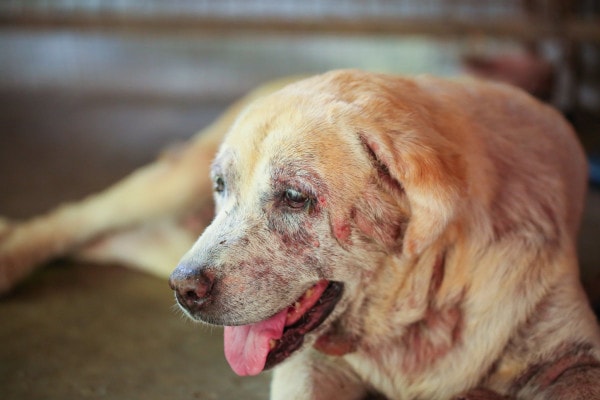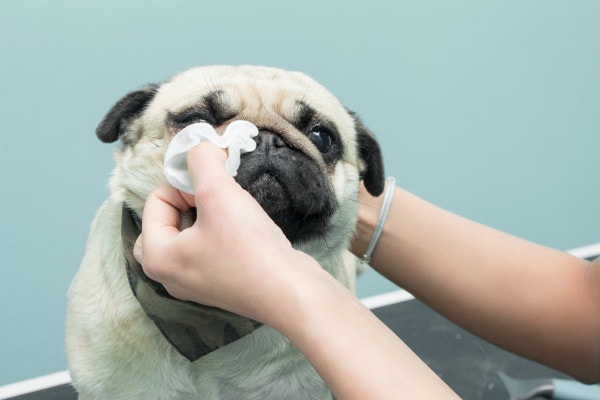Figuring out how to tell if your dog is sick, or just tired or having an off day can be challenging. You don’t want to overreact, but you also don’t want to ignore the signs that something is wrong. To help dog parents recognize a sick dog, integrative veterinarian Dr. Julie Buzby explains 15 signs your dog is sick, what each one might mean for your dog, and when to call the vet.

Veterinarians often field calls from dog owners asking, “How do I tell if my dog is sick, depressed, or just tired?” Or “My dog is doing XYZ. Does that mean he or she is sick?” These are understandable questions, and I’m glad that my clients are tuned into their furry friend’s health.
While I can’t give them, or you, an exact formula for recognizing if a dog is sick or not, there are some common symptoms and behaviors that might indicate a dog isn’t feeling good. Let’s take a look at how to tell if your dog is sick, 15 symptoms to watch for, and when you should call your vet.
The first step: Knowing what is normal for your dog
In order to recognize that your dog is sick, you must first know what is normal for your dog. This means having an idea of what your dog likes to eat and how much, how often your dog likes to play or go on walks, and other information about a typical day for your dog. But that’s not all.
It’s also helpful if you know what is physically normal for your dog. Now, I don’t expect you to be able to perform full exams on your dog at home—that’s your veterinarian’s job.
But, as a dog parent, you should routinely “examine” your dog so you can have an idea of what is normal for him or her. For example, you should know what your dog’s gums look like, belly feels like, and ears smell like when he or she is feeling good. Having this baseline will help you quickly and easily detect when something is abnormal.
Learning the at-home dog health scan
The best way to learn your dog’s normal is to make a habit of once or twice a month (or more frequently if your dog has a chronic or concerning condition) performing a 5-minute dog wellness scan. You can do this by running your hand over every inch of your dog’s body (sort of like a full-body massage). And then you can look inside your dog’s mouth, eyes, and ears.
If you want more details about how to perform this scan at home or don’t know what “normal” should look like, I recommend completing my course, Dr. Buzby’s Tip-to-Tail Dog Health Scan™. In this course, I use videos and infographics to teach you how to assess aspects of your dog’s health in the comfort of your own home through 10 purposeful touches.
By performing a health scan regularly when your dog is healthy, you will quickly memorize what is normal for your dog. Then, if one day you perform your exam and something feels different, you won’t be left wondering if that is normal for your dog or not.
After all, how can you know if something is wrong if you don’t know what is right (or normal)?
The second step: Looking for signs your dog is sick
Once you have considered what is normal for your dog, you are ready for the second step—recognizing the common signs that indicate that your dog might be sick.
Despite the old wives’ tale, it’s not usually as easy as feeling your dog’s nose to see if it is warm or dry. Because even if it is, it does not automatically mean that he or she is sick. Some dogs naturally have drier noses while others may have very wet noses.
Instead, you need to look at your dog’s behavior, appearance, and symptoms. To help you out, I put together a list of 15 signs that tell you your dog might be sick.
15 signs your dog is sick
- Your dog is vomiting and/or having diarrhea
- Your dog isn’t eating as much as normal
- Your dog’s water consumption has changed
- Your dog has bad breath
- Your dog has unexpectedly lost or gained weight
- Your dog is limping or having trouble walking
- Your dog suddenly collapses or becomes extremely weak
- Your dog is having seizures
- Your dog’s gums are pale
- Your dog is coughing, having trouble breathing, or breathing abnormally
- Your dog’s personality has changed
- Your dog is urinating abnormally and/or having urinary accidents
- Your dog’s skin is bumpy, red, or itchy, or your dog is losing hair
- Your dog’s ears are smelly or irritated
- Your dog’s eyes are cloudy, red, or painful, or your dog cannot see
Let’s take a look at each of those signs in a bit more detail.

1. Your dog is vomiting and/or having diarrhea
One of the most common questions I receive from owners is, “My dog is throwing up and has diarrhea. Is he or she sick?” Chances are good that the answer is “yes.” But there are some situations where a dog with vomiting or diarrhea isn’t truly sick.
For example, some dogs might vomit because they drank water too quickly or ate grass while outside. Your dog might throw up once, and then go back to playing as though nothing had ever happened. In this case, one episode of vomiting would probably not indicate that your dog is sick.
On the other hand, your dog might be sick if he or she is experiencing:
- Prolonged (i.e. occurring over two or more days) or profuse (i.e. occurring frequently or in large quantities) diarrhea or vomiting
- Vomiting or diarrhea that is bloody or contains foreign objects
- Diarrhea that contains mucous
- Vomiting or diarrhea plus other symptoms (e.g. dehydration, weight loss, lack of appetite, weakness, etc.)
If you are seeing some of those symptoms, please make an appointment with your veterinarian. Dehydration from vomiting and diarrhea, as well as some of the conditions that cause vomiting or diarrhea, can be dangerous for your dog.
Causes of vomiting and/or diarrhea
Since vomiting and diarrhea are fairly non-specific signs, they can accompany a wide variety of conditions—both gastro-intestinal (GI) and non-GI in origin.
While this is far from an exhaustive list, some of the more common conditions that may cause vomiting and/or diarrhea include:
- Parvovirus (a potentially fatal viral disease) or other viral, bacterial, or fungal diseases
- Pancreatitis in dogs
- Dietary indiscretion (i.e. eating something he or she shouldn’t) or a GI foreign body
- Exposure to a toxin (e.g. the dog ate chocolate)
- Motion sickness from vestibular disease in dogs or dog car sickness
- GI parasites
- Kidney disease
- Liver disease
- Inflammatory bowel disease (IBD in dogs)
2. Your dog isn’t eating as much as normal
Dogs with vomiting and/or diarrhea, or other dogs who are sick, often also have a decreased appetite. If your dog has stopped eating, it might indicate your dog’s stomach is upset or his or her mouth is painful. Or your dog may just generally be feeling crummy and have no interest in eating.
Some of the more common diseases that might lead to a dog not eating include:
- Kidney failure in dogs
- Liver disease in dogs
- Dietary indiscretion or foreign body
- Pancreatitis
- Cancer (e.g. liver cancer in dogs, lymphoma in dogs, prostate cancer in dogs, or most other cancers)
- Dental disease in dogs (dog losing teeth, dog tooth abscess, broken tooth, or other causes of dental pain)
- Fungal, bacterial, or viral infections
- Heart or lung diseases
I’ve tried to keep it fairly short, but be advised that this list could go on for pages. “Not eating” is a common symptom of many conditions.
Is my dog sick or just not hungry?
Sometimes dog parents tell me, “My dog won’t eat, but I don’t know if he is sick or not hungry.” It can be difficult to make this distinction. But offering a special treat can sometimes shed some light on the situation.

A dog who isn’t that hungry or is generally picky might not eat the kibble for dinner. But he or she would quickly scarf up a piece of turkey that smells good. However, a dog who normally loves food but won’t eat kibble and also won’t eat a piece of turkey or a dog biscuit is probably more likely to be feeling sick.
Ultimately though, the best advice I can give you is to trust your instincts. You know your dog well, so if you are concerned with your dog’s eating habits, please contact your vet.
3. Your dog’s water consumption has changed
Sometimes dogs who aren’t eating well (or other dogs who are sick) will also stop drinking water. But some sick dogs may actually start drinking more water instead.
Both decreased and increased thirst in dogs can be a sign of a problem, which is why I recommend dog parents pay attention to how often they are filling the water bowl. Additionally, since drinking more water and urinating more often go hand in hand, I also advise dog parents to take note of how often their dog needs to go outside.
Many of the conditions that cause a decreased appetite can also decrease water intake, so we will just focus on the causes of increased water consumption in this section.
Some common causes of increased thirst (i.e. polydipsia or PD) and increased urinary volume (i.e. polyuria or PU) include:
- Diabetes in dogs (i.e. diabetes mellitus)
- Kidney disease in dogs
- Cushing’s disease in dogs
- Diabetes insipidus in dogs
- Pyometra in dogs (i.e. uterine infection)
- Hypercalcemia in dogs
If you see changes in your dog’s water intake, please contact your vet. He or she can perform some diagnostics to get to the bottom of the PU/PD (i.e. increased urination and thirst) or decreased water consumption.
4. Your dog has bad breath
Dogs who are sick may also have bad breath. If your dog has a broken or loose tooth, a tooth root abscess, or significant periodontal disease, his or her breath may stink. While dental disease should certainly warrant a veterinary appointment, it is not typically life-threatening.
On the other hand, there are some far more serious causes of bad breath. For example, dogs who are in the advanced stages of kidney disease in dogs may have breath that smells like ammonia (i.e. uremic breath). And breath that smells like acetone (i.e. nail polish remover) may indicate that your dog has diabetic ketoacidosis (DKA) in dogs, which is a life-threatening complication of diabetes mellitus.
Therefore, when in doubt, it is safest to make an appointment with your vet if your dog has bad breath.
5. Your dog has unexpectedly lost or gained weight
Sick dogs may also experience unexplained weight loss or weight gain.

Unexpected weight loss in general can be concerning. But dogs who lose weight quickly or dogs who are losing weight but eating increased amounts of food are even more likely to be sick. Weight loss can be associated with a variety of problems including:
- Dental disease
- Stomach upset and gastrointestinal disease (e.g. parasites, IBD, etc)
- Cancer
- Kidney disease
- Liver disease
- Hormonal or endocrine diseases (i.e. diabetes, Cushing’s disease, Addison’s disease in dogs, etc.)
- Heart disease
On the other hand, unexpected weight gain can also signal a problem. The rapid development of a pot-bellied dog appearance could indicate the dog is bleeding internally from a ruptured splenic mass in dogs (or other problem) or has bloat in dogs (i.e. gastric dilation and volvulus or GDV). Both of these are life-threatening conditions and require an emergency vet visit.
Alternatively, slow weight gain without an increase in calorie consumption can be associated with hypothyroidism in dogs or Cushing’s disease. (Yes, Cushing’s disease is on both lists—it can can cause weight gain or loss.)
Anytime you are concerned with your dog’s weight, I recommend determining your dog’s body condition score (BCS) and tracking it over time. This can help you see if your dog is losing or gaining weight without having to hoist your dog onto your scale at home.
Plus, it is helpful to have a conversation with your dog’s vet about your dogs weight, especially if your dog is gaining weight. Even if your dog isn’t sick now, weight gain can put more strain on the internal organs, bones, and joints. This can lead to your dog getting sick or having difficulty moving around in the future.
6. Your dog is limping or having trouble walking
Dogs who are limping or having trouble walking may also be sick with a wide range of conditions. If your dog has gradually been having a more difficult time walking or going up and down stairs, seems stiff, or is slipping on floors, it could indicate that your dog has osteoarthritis in dogs (which is probably the most common cause of difficulty walking and limping in senior dogs) or another orthopedic condition.
On the other hand, dogs can also be weak from diseases like Addison’s disease, myasthenia gravis in dogs, degenerative myelopathy in dogs, IVDD in dogs, or geriatric onset laryngeal paralysis polyneuropathy (GOLPP).
Rapid onset limping (especially if severe) could indicate an painful condition such as osteosarcoma in dogs (i.e. bone cancer), a torn ACL in dogs, a broken toe in dogs, the dog ripped a nail off, a dog paw pad injury, or other injury. In these cases, it is important to get to your vet promptly.
And while slowly progressive stiffness, weakness, or difficulty walking isn’t an emergency, I do also recommend making an appointment with your vet. There are so many medications and strategies to relieve arthritis pain in dogs. And treating the underlying disease that caused the weakness (e.g. myasthenia gravis) can make a big difference.
Additionally, Dr. Buzby’s ToeGrips® dog nail grips can be a great solution for dogs who are weak or painful and slipping on the floor.
7. Your dog suddenly collapses or becomes extremely weak
Sudden weakness or collapse are symptoms of sickness that should be taken very seriously. If you find yourself saying, “My dog is shaking and can’t stand up,” or “My dog just fell to the ground,” it is important you get to the vet for an emergency vet visit ASAP. Dogs who collapse are usually sick with a potentially life-threatening condition such as:
- Heat stroke or heat exhaustion in dogs
- Heart disease in dogs or abnormal heart rhythms
- Internal bleeding
- Seizures
- Allergic reaction (i.e. anaphylaxis)
- Low blood sugar

Let me say it again. If your dog collapses, please take your dog to the veterinarian right away. Even if he or she recovers quickly, dogs who collapse should always see a veterinarian.
8. Your dog is having seizures
Just like sudden collapse, seizures in dogs can be a scary, and potentially serious, sign of sickness. Sometimes seizures can cause your dog to stiffen, collapse, shake, urinate, defecate, and paddle. However, other dogs may have very mild seizures. They might stare off into space and tremble without ever falling down or losing consciousness.
Or dogs might even have dog head tremors, which look like mild seizures but actually aren’t seizures at all.
Seizures can occur due to:
- Idiopathic epilepsy (i.e. seizures with an unknown origin)
- Brain inflammation
- Brain tumors
- Low blood sugar
- Exposure to toxins (e.g. the sugar substitute xylitol can make dogs have seizures)
Regardless of the severity, it is always a good idea to contact your vet the first time you see your dog have a seizure or seizure-like episode. And if your dog has a known seizure condition (regardless of if he or she is on anti-seizure medications), reach out to your vet if your dog’s seizures are increasing in frequency, length, or severity.
9. Your dog’s gums are pale
Pale gums can be a serious symptom in dogs who are sick with many different diseases. When I say “pale gums” what I mean is gums that are not the normal bright pink. Depending on the severity of the condition, the dog’s gums may be light pink, bluish, or almost white.
Some causes of pale gums include:
- Anemia in dogs (including causes of anemia in dogs such as immune-mediated hemolytic anemia (IMHA in dogs))
- Blood loss from a ruptured hemangiosarcoma in dogs (i.e. a type of cancer that most commonly affects the spleen, liver, or heart)
- Toxin exposure (e.g. anti-coagulant rodenticide)
- Shock (due to trauma, anaphylaxis, sepsis, etc.)
- Heart disease in dogs
- Severe dehydration
Many of the diseases that cause pale gums require immediate veterinary care and can be life-threatening. This means that if you notice your dog’s gums look abnormal, you should bring your dog to the veterinarian right away.
10. Your dog is coughing, having trouble breathing, or breathing abnormally
Dogs who are sick may be coughing or wheezing. Or they may show changes in the rate, depth, or effort of their breathing. Depending on the problem, the dog may have symptoms such as:
- Excessive panting or drooling
- Wheezing
- Coughing (or a dog who is coughing and gagging)
- Nasal discharge
- Struggling to breathe or gasping for air
- Standing with the neck outstretched and the elbows directed outward
- Heavy, abdominal breathing
- Dog who is breathing fast
- Shallow breathing
- Noisy breathing (harsh, high-pitched, or snoring sounds)
- Sounding like the dog is choking
Coughing or gagging tend to happen due to irritation to the airways or throat. And abnormal or difficult breathing indicates your dog is struggling to get enough oxygen. These signs could be occurring for a variety of reasons, including:
- Lung disease (e.g. pneumonia, lung cancer, chronic bronchitis in dogs, or other respiratory problems)
- Congestive heart failure due to heart disease in dogs
- Laryngeal paralysis in dogs
- Collapsed trachea in dogs
- Brachycephalic airway obstruction syndrome in flat-faced dogs
Difficulty breathing is always an emergency, especially if the dog is turning blue. If you have any question in your mind about how well your dog is breathing, the best thing you can do is get to your vet or an veterinary emergency clinic as soon as you can.
11. Your dog’s personality has changed

Unfortunately, our dogs cannot talk and tell us what is wrong. Instead, they use their body language and behavior to communicate with us as best they can. This means that when your dog is sick, he or she might start acting different than normal.
The exact personality changes can depend on the individual dog and what kind of sickness that dog is experiencing. Some dogs might have subtle changes such as not wanting to play as much or taking more naps when they are sick. But a different dog who is sick may have more obvious signs like hiding or being a lethargic dog.
You may also see signs your dog is in pain such as withdrawing from the family or being extra clingy. Painful dogs may also become more irritable and snap at people or pets. With more intense pain, your dog may even vocalize or cry out.
Being an attentive dog parent is very important for recognizing personality changes associated with sickness in your dog. These differences are something that another person (like your veterinarian) may not be able to detect unless they are obvious. So if you think your dog is acting abnormally, trust your gut. Your dog might be trying to tell you he or she is sick.
12. Your dog is urinating abnormally and/or having urinary accidents
Unlike personality changes, which can be subtle, inappropriate or abnormal urination is often an easy-to-recognize sign of sickness. Most people will know if their dog is urinating in the house or on the sofa because they will find the spots of urine. And if your dog is suddenly wanting to go outside to urinate every hour or straining to urinate, that will probably catch your attention.
The term “inappropriate or abnormal urination” can encompass several scenarios.
- The dog is suddenly peeing more than normal (either more volume or at an increased frequency)
- A previously house-trained dog is now having accidents in the house
- The dog is peeing in his or her sleep without waking up or noticing
- The dog is straining to urinate, is unable to urinate, or has blood in the urine
Any of these changes in urinary habits are considered abnormal. And they could mean the dog is sick with diseases such as:
- Urinary tract infection (UTI in dogs)
- Bladder or kidney stones
- Enlarged prostate in dogs
- Urinary obstruction
- Kidney infection (i.e. pyelonephritis in dogs)
- Kidney failure
- Diabetes mellitus
- Cushing’s disease
- Diabetes insipidus
- Bladder cancer in dogs
- Urinary incontinence in dogs
If your dog cannot urinate, this is an emergency. Please bring your dog to your vet or emergency veterinarian immediately. Otherwise, for dogs who are still urinating, but urinating abnormally or inappropriately, schedule an appointment with your veterinarian.
13. Your dog’s skin is bumpy, red, or itchy, or your dog is losing hair

Changes in your dogs skin or coat, such as hair loss, a patchy rough coat, or irritated or itchy skin can also indicate your dog may be sick. Dogs who are healthy and have well balanced diets should have smooth, clean coats that grow evenly. But when dogs are sick, you may notice changes such as:
- Hair loss
- Red, irritated skin
- Itchy skin or itchy paws in dogs
- Excessive biting or licking at the skin (such as on the feet, ears, or abdomen)
- Coats that are greasy or have excessive dandruff
- Skin that is painful to the touch
- Areas of the skin that are swollen or have discharge
- A tumor on a dog’s paw or lumps on or under the skin
If your dog is experiencing some mild skin issues, you can try bathing your dog in a soothing dog shampoo. If your dog’s coat and comfort improve after the bath, it is possible that something irritating (such as dirt, weeds, or debris) had been touching your dog’s skin or trapped in the fur.
But, if the symptoms persist after a bath or worsen, your dog may have:
- Allergies
- Parasites (such as fleas or ticks)
- Poor nutrition
- Bacterial or fungal skin infection (e.g. pyoderma in dogs or dog paw yeast infections)
- Cushing’s disease
- Hypothyroidism
- Tumors such as a mast cell tumor in dogs or a lipoma in dogs
If you notice changes to your dog’s skin or coat, or any lumps or bumps pop up on your dog’s skin, it is best to make a veterinary appointment. In preparation for the visit, ensure you know when you noticed the problem, what it looked like then versus now, what (if anything) seemed to help your dog, and if your dog is showing any other symptoms.
14. Your dog’s ears are smelly or irritated
If your dog has skin issues (or even if he or she doesn’t), you should always check inside your dog’s ears to see if they look and smell normal. Dogs who have allergies, parasites, or skin infections are more likely to develop ear infections (i.e. otitis in dogs). Your dog can also develop ear problems if he or she has something in the ear that shouldn’t be there (such as a foxtails in dogs).
Some signs that you might notice if your dog is sick with an ear problem include:
- Excessive head shaking
- Frequent scratching at the ears
- Whimpering or yelping when the ears are touched or scratched
- Abnormal odor coming from inside the ear
- Large amounts of debris or wax in the ear (usually it is brown or black in appearance)
- Blood in the ear canal
- Visible foreign bodies in the ear
- Hearing loss in dogs
If your dog is showing any of these symptoms, it would be a good idea to make an appointment with your vet. Ear problems can be quite painful and irritating for many dogs.
15. Your dog’s eyes are cloudy, red, or painful, or your dog cannot see
While you are looking at your dog’s ears, you should also check your dog’s eyes for abnormalities that might indicate that he or she is sick. Eyes can sometimes be more difficult to detect changes in, so it is important to inspect them closely if you think something is wrong. For example, you might notice:
- Excessive pawing or rubbing at the face
- Hair loss around the eye
- Increased tearing or drainage from the eye
- Yellow or green discharge
- Bulging or swelling around the eye
- Squinting or keeping the eye shut
- Cloudy eyes in dogs
- Redness of the inner eyelids or surface of the eyeball
- Color change in the iris (i.e. colored part of the eye)
- Sudden blindness

These symptoms can be a sign that your dog has:
- Dry eye in dogs (keratoconjunctivitis sica or KCS)
- Corneal ulcer in dogs
- Uveitis in dogs
- Cataracts in dogs
- Glaucoma in dogs
- Dog eye melanoma
- Sudden acquired retinal degeneration syndrome (SARDS)
If you notice changes to your dog’s eyes, it is important to make an appointment with your vet quickly. Some eye problems can worsen rapidly and result in your dog losing an eye or becoming blind.
What should you do if you think your dog is sick?
Recognizing that your dog is sick is not always easy. But if you have noticed any of the 15 symptoms of sickness discussed above (or something not on the list has you concerned), the best thing you can do is give your vet a call.
The veterinary team would be more than happy to talk with you about your dog’s symptoms and help you decide if your dog needs to be seen, and if so, how urgently. There may be cases where they can make some recommendations for home remedies over the phone. Other times, the veterinary team may suggest making an appointment that day, or in a few days. Or, in the case of an emergency situation, they can help direct you either to their hospital, or to an emergency clinic.
You have an important job as a dog parent
As we wrap up, I want to take a moment to remind you of the important role you play in your dog’s health. You know your dog better than anyone else. You spend the most time with your dog, and you have learned your dog’s favorite food, toy, bed, activities, and more. No one else knows this much information about your dog.
Therefore, you are the perfect person to notice changes in your dog’s behavior, activity, and attitude. When you pay attention to things that seem out of the ordinary and know how to recognize signs that your dog is sick, you can more effectively advocate for your dog.
And by noticing those changes and enlisting the help of your veterinarian, you can give your dog the best chance of recovering well. So if you think your dog might be sick, don’t delay. Reach out to your veterinarian for advice, and start the process of restoring your dog’s health and happiness.


We welcome your comments and questions about senior dog care.
However, if you need medical advice, diagnosis, or treatment, please contact your local veterinarian.